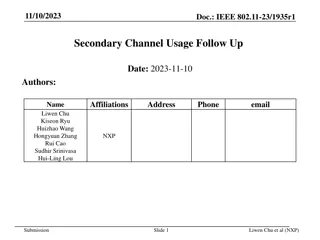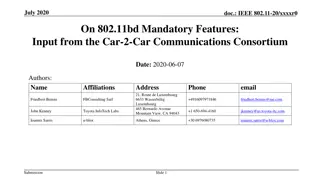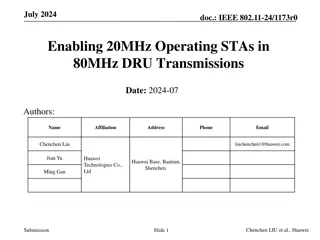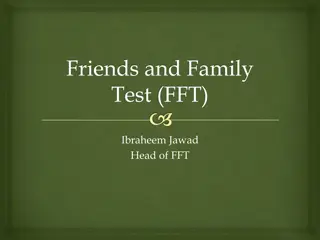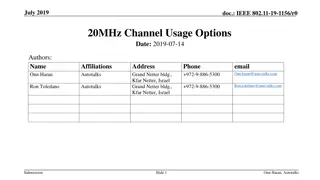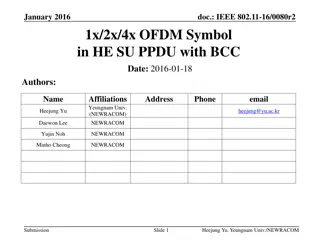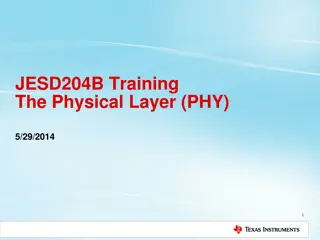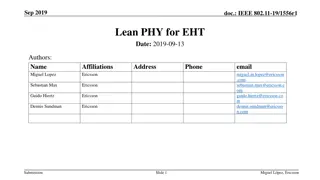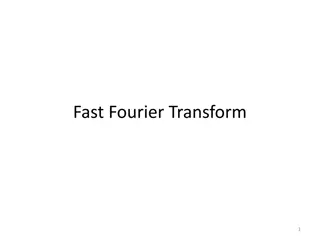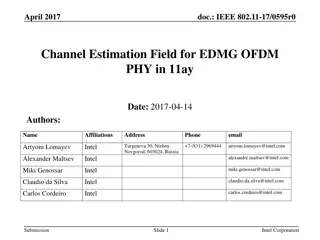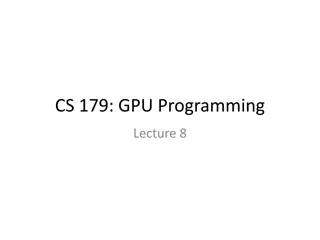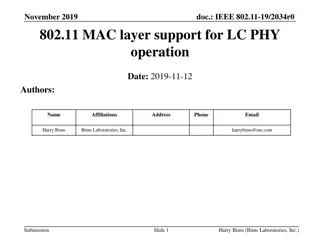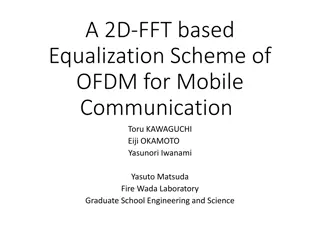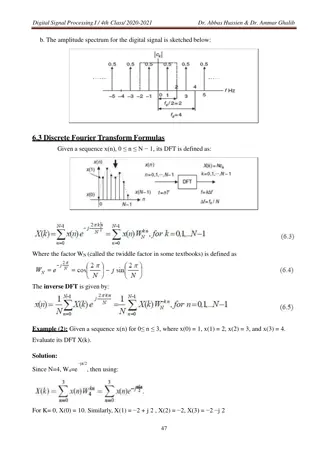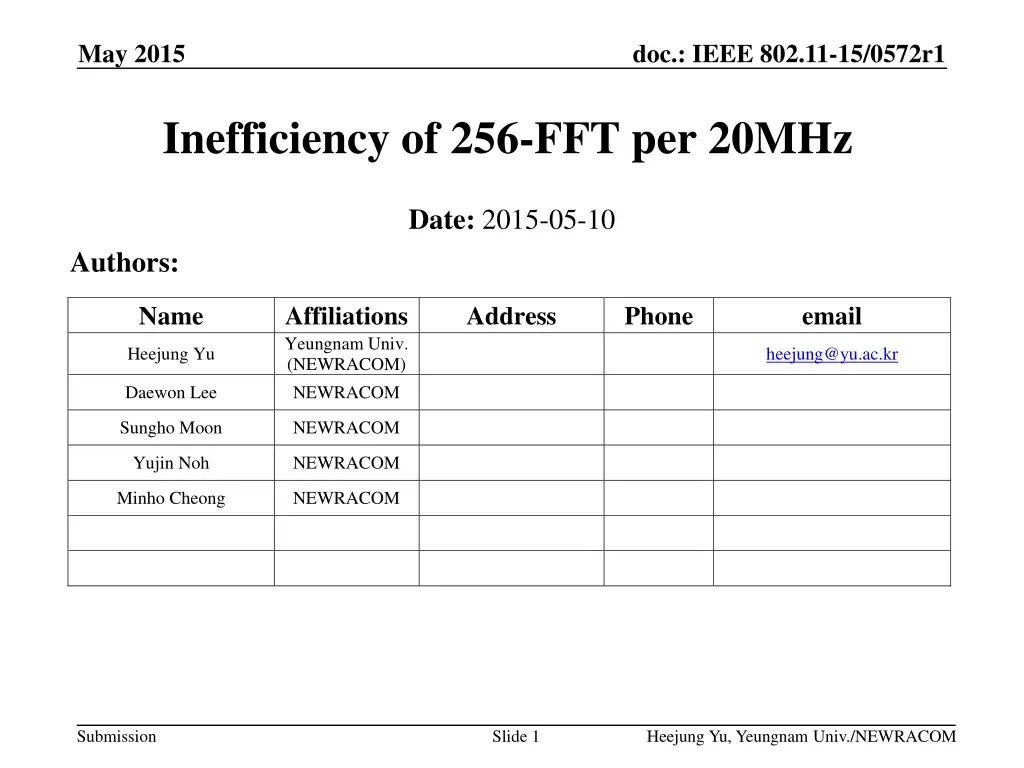
IEEE 802.11-15/0572r1 Efficiency Challenges in Wireless Communication
Explore the inefficiencies of the 256-FFT per 20MHz bandwidth in IEEE 802.11 communication standards. Issues such as padding overhead, MAC throughput loss, and inefficiencies in STBC cases are discussed. Discover the impact on data transmission and efficiency in short packet scenarios.
Download Presentation

Please find below an Image/Link to download the presentation.
The content on the website is provided AS IS for your information and personal use only. It may not be sold, licensed, or shared on other websites without obtaining consent from the author. If you encounter any issues during the download, it is possible that the publisher has removed the file from their server.
You are allowed to download the files provided on this website for personal or commercial use, subject to the condition that they are used lawfully. All files are the property of their respective owners.
The content on the website is provided AS IS for your information and personal use only. It may not be sold, licensed, or shared on other websites without obtaining consent from the author.
E N D
Presentation Transcript
May 2015 doc.: IEEE 802.11-15/0572r1 Inefficiency of 256-FFT per 20MHz Date: 2015-05-10 Authors: Name Affiliations Yeungnam Univ. (NEWRACOM) NEWRACOM Address Phone email Heejung Yu heejung@yu.ac.kr Daewon Lee Sungho Moon NEWRACOM Yujin Noh NEWRACOM Minho Cheong NEWRACOM Submission Slide 1 Heejung Yu, Yeungnam Univ./NEWRACOM
May 2015 doc.: IEEE 802.11-15/0572r1 Background According to SFD [1], data symbols in an HE PPDU shall use a DFT period of 12.8 s and subcarrier spacing of 78.125 kHz. 256 subcarriers are defined in 20MHz bandwidth. The longer symbol duration can cause excessive padding in the last OFDM symbol. Especially when sending short packets, transmission efficiency drops due to padding In STBC cases, the padding overhead becomes larger. Submission Slide 2 Heejung Yu, Yeungnam Univ./NEWRACOM
May 2015 doc.: IEEE 802.11-15/0572r1 Padding inefficiency In 11ac, EOF padding in MAC layer and PHY padding was used to fill all data tones in the last OFDM symbol. When an OFDM symbol contains more data tones (roughly x4), more redundant padding bits may be needed. In 80MHz BW, several hundreds redundant data tones can be transmitted to send few bits in the last symbol. Especially in a short packet case, MAC throughput loss cannot be avoided. In a STBC case, the last two OFDM symbols have such inefficiency. Submission Slide 3 Heejung Yu, Yeungnam Univ./NEWRACOM
May 2015 doc.: IEEE 802.11-15/0572r1 Ratio btw padding bits and data bits (1) Channel BW = 80MHz 980 data tones assumed MCS MCS0 MCS8 MIMO scheme 1STS 1STS + STBC 2STS Submission Slide 4 Heejung Yu, Yeungnam Univ./NEWRACOM
May 2015 doc.: IEEE 802.11-15/0572r1 Ratio btw padding bits and data bits (2) BW = 80MHz(950 data tones), MSC8, Nss=1, STBC=1 8 BW = 80MHz(950 data tones), MSC8, Nss=2, STBC=1 8 500 500 (padding bits)/(payload bits including MAC header)*100 (%) (padding bits)/(payload bits including MAC header)*100 (%) 450 450 400 400 350 350 300 300 250 250 200 200 150 150 100 100 50 50 0 0 500 1000 1500 2000 2500 3000 3500 4000 4500 5000 500 1000 1500 2000 2500 3000 3500 4000 4500 5000 payload(byte) payload(byte) MCS8 1STS MCS8 2STS Submission Slide 5 Heejung Yu, Yeungnam Univ./NEWRACOM
May 2015 doc.: IEEE 802.11-15/0572r1 Ratio btw padding bits and data bits (3) BW = 80MHz(950 data tones), MSC0, Nss=1, STBC=1 8 BW = 80MHz(950 data tones), MSC0, Nss=1, STBC=2 8 200 200 (padding bits)/(payload bits including MAC header)*100 (%) (padding bits)/(payload bits including MAC header)*100 (%) 180 180 160 160 140 140 120 120 100 100 80 80 60 60 40 40 20 20 0 0 200 400 600 800 1000 1200 1400 1600 1800 2000 200 400 600 800 1000 1200 1400 1600 1800 2000 payload(byte) payload(byte) MCS0 1STS MCS0 1STS+STBC Submission Slide 6 Heejung Yu, Yeungnam Univ./NEWRACOM
May 2015 doc.: IEEE 802.11-15/0572r1 Ratio btw padding bits and data bits (3) To send 1000 bytes data payload in 80MHz BW, MCS0 with STBC : 10.25% padding is needed (100 bytes) MCS8 with Nsts = 1 : 47% padding is needed (470 bytes) Large padding bits are needed by when using 12.8us OFDM symbol duration. As shown in the appendix, MAC throughput can drop significantly due to variation of padding bits. Submission Slide 7 Heejung Yu, Yeungnam Univ./NEWRACOM
May 2015 doc.: IEEE 802.11-15/0572r1 Ratio btw padding bits and data bits (4) Padding bits with typical packets 40 +44bytes1 45.8% 45.8% 119% 192% 338% 483% 556% 629% 775% 576+44bytes2 8.67% 18.6% 18.6% 18.6% 18.6% 58.1% 77.8% 97.6% 18.6% 1500+44bytes3 3.14% 3.14% 7.11% 11.1% 19.0% 26.9% 7.11% 19.0% 42.8% MCS0 (80MHz, NSTS = 1) MCS1 (80MHz, NSTS = 1) MCS2 (80MHz, NSTS = 1) MCS3 (80MHz, NSTS = 1) MCS4 (80MHz, NSTS = 1) MCS5 (80MHz, NSTS = 1) MCS6 (80MHz, NSTS = 1) MCS7 (80MHz, NSTS = 1) MCS8 (80MHz, NSTS = 1) 1 IPv4 TCP/IP ACK (without option) : 40 bytes + 4 bytes (A-MPDU header) + 32 bytes (MAC header + FCS) + 3 bytes (LLC header) + 5 bytes (SNAP extension LLC header) 2 Minimum IPv4 datagram size : 567 bytes + 44 (MAC & LLC overhead) 3 Ethernet MTU : 1500 bytes + 44 bytes (MAC & LLC overehead) Submission Slide 8 Heejung Yu, Yeungnam Univ./NEWRACOM
May 2015 doc.: IEEE 802.11-15/0572r1 Conclusions 12.8us OFDM symbol duration can cause excessive padding and result in throughput loss. Especially for OFDM transmission with wide BW, high MCS, and many STSs. Submission Slide 9 Heejung Yu, Yeungnam Univ./NEWRACOM
May 2015 doc.: IEEE 802.11-15/0572r1 Straw Poll #1 Do you support the concept HE shall include mechanisms to enhance the MAC/PHY padding efficiency for OFDM transmissions using symbol duration of 12.8usec. Submission Slide 10 Heejung Yu, Yeungnam Univ./NEWRACOM
May 2015 doc.: IEEE 802.11-15/0572r1 Reference [1] 11-15-0132-04-00ax-Specification Framework for Tgax [2] 11-15-0330-01-00ax-OFDMA-numerology-and- structure Submission Slide 11 Heejung Yu, Yeungnam Univ./NEWRACOM
May 2015 doc.: IEEE 802.11-15/0572r1 Appendix Submission Slide 12 Heejung Yu, Yeungnam Univ./NEWRACOM
May 2015 doc.: IEEE 802.11-15/0572r1 Numerical evaluation: Padding inefficiency 11ac : current frame structure with 0.8us CP 11ax : 12.8us OFDM symbol duration plus 3.2us CP L-STF 8us L-LTF 8us L-SIG 4us HE-SIGA 8us HE-STF 4us HE-LTF 16us*Nss HE-SIG B 16us HE-DATA 16us * N OFDM symbol BW = 20MHz 80MHz 11ac : 52 data tones 234 data tones 11ax : 234 data tones 980 data tones Submission Slide 13 Heejung Yu, Yeungnam Univ./NEWRACOM
May 2015 doc.: IEEE 802.11-15/0572r1 MCS0, Nsts =1, 80MHz STBC off STBC on BW = 80MHz(950tones+16tones), MSC0, Nss=1, STBC=1 8 BW = 80MHz(950tones+16tones), MSC0, Nss=1, STBC=2 8 30 30 25 25 20 20 throughput (Mbps) throughput (Mbps) 15 15 10 10 5 5 11ac 11ax 11ac 11ax 0 0 500 1000 1500 2000 2500 3000 500 1000 1500 2000 2500 3000 payload(byte) payload(byte) Submission Slide 14 Heejung Yu, Yeungnam Univ./NEWRACOM
May 2015 doc.: IEEE 802.11-15/0572r1 MCS8, 80MHz Nsts = 1 Nsts = 2 BW = 80MHz(950tones+16tones), MSC8, Nss=1, STBC=1 8 BW = 80MHz(950tones+16tones), MSC8, Nss=2, STBC=1 8 600 300 11ac 11ax 11ac 11ax 500 250 400 200 throughput (Mbps) throughput (Mbps) 300 150 200 100 100 50 0 0 0 1000 2000 3000 4000 5000 6000 7000 8000 9000 10000 0 1000 2000 3000 4000 5000 6000 7000 8000 9000 10000 payload(byte) payload(byte) Submission Slide 15 Heejung Yu, Yeungnam Univ./NEWRACOM
May 2015 doc.: IEEE 802.11-15/0572r1 MCS8, 20MHz STBC off STBC on BW = 20MHz, MSC8, Nss=1, STBC=1 BW = 20MHz, MSC8, Nss=1, STBC=2 90 90 80 80 70 70 60 60 throughput (Mbps) throughput (Mbps) 50 50 40 40 30 30 20 20 11ac 11ax 11ac 11ax 10 10 0 0 0 1000 2000 3000 4000 5000 6000 7000 8000 9000 10000 0 1000 2000 3000 4000 5000 6000 7000 8000 9000 10000 payload(byte) payload(byte) Submission Slide 16 Heejung Yu, Yeungnam Univ./NEWRACOM


